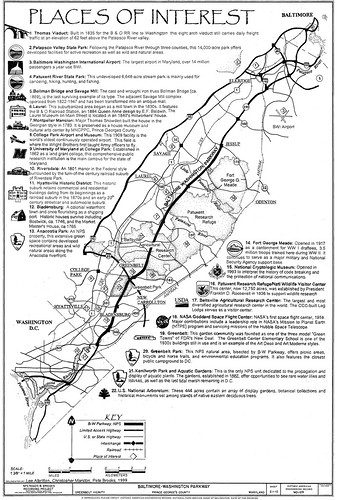Baltimore-Washington Parkway Widening Feasibility Study
 I haven't seen any recent articles about this process in the local media (Gazette newspapers, Washington Post, etc.) but happened on an online ad on the process.
I haven't seen any recent articles about this process in the local media (Gazette newspapers, Washington Post, etc.) but happened on an online ad on the process. A Gateway to our Nation's Capital
Enjoy the scenic entryway into our Nation's Capital. Opened in 1954, the parkway is a 29-mile scenic highway that connects Baltimore, Maryland with Washington, D.C.
The parkway is a part of four parkways that welcome visitors and integrate a design to convey to citizens the importance of the capital city. The NPS manages the parkway from the D.C. boundary to Fort Meade, Maryland.
The study was supposed to be finished last month, but there is a public meeting, the third, scheduled for this week:
February 16, 2012
6:30pm to 8:30 pm
Greenbelt Community Center
15 Crescent Road
Greenbelt, MD 20770
The study examines "the feasibility of adding a third northbound and a third southbound land to the BWI Parkway between the interchange wtih I-695 in Anne Arundel County Maryland, and New York Avenue in the Distict of Columbia."
According to the website:
The study is the result of legislative language included in Fiscal Year 2010 Appropriations legislation sponsored by Congressman C. A. Dutch Ruppersberger, Maryland District 2, directing the FHWA to work with the National Park Service (NPS) and the Maryland State Highway Administration (SHA) to determine the feasibility of such a widening. The study will include an assessment of the impact of the Base Realignment and Closure (BRAC) process on traffic throughout the Maryland Route 295 corridor between Baltimore, MD and Washington, DC.
Interestingly, the Congressman who initiated the study is from Baltimore County, while much of the impact from a widening project would be in the DC region. While the B-W Parkway doesn't enter DC per se, it is a key north-south "freeway" -- a "parkway" actually, so that it is supposed to be park-like rather than concrete-like.
It connects to DC via Route 50 (New York Avenue).
In any case, the study should consider adding a continuous bikeway as part of any widening project, even though my predilection might be for no widening. Note that the State of Connecticut is studying adding a continuous trail to the Merritt Parkway ("Walking the Merritt Parkway: ConnDOT considers a multi-use trail," Trumbull Patch).
It is a little known fact that bikeways can be included in FHWA-funded "freeway"/Interstate projects, it depends on the policies of the local state. Maryland happens to not integrate bikeways into Interstate projects generally, although there are instances of bridge crossings for trails and walkways, mostly in the DC area, with the Wilson Bridge, and crossing the Beltway next to Georgia Avenue in association with the Forest Glen subway station. The City of Rockville has also created walk-bike bridges over I-270.
And there is an award-winning project that was integrated into I-70 in Colorado that is a national model that should have been transmitted to all states as a best practice example of what could be achieved.
-- "Glenwood Canyon, 12 Years Later," Public Roads Magazine, FHWA
1. Note that it is projects like these--biking and pedestrian integration projects--that are to be eliminated from funding in the proposed Federal Transportation Bill (see "" by Neal Peirce)
2. Although the basic point really is that a complete transportation demand management program should have been created with regard to the transportation impact of BRAC-related base relocations to Fort Meade and the Aberdeen Proving Ground in Maryland, with a focus on minimizing the generation of new trips.
Only in that context should a widening of BW Parkway be considered.
Labels: bicyling, parks planning, transportation planning




0 Comments:
Post a Comment
<< Home